Sunglasses Size Calculator
After long months of lockdowns and isolation, we're all craving some sunlight ☀️ Everywhere you look, people are grilling, doing sports, sunbathing, and doing everything they can to get the most out of their time outside. Even this year's unrelenting heat is not stopping us from enjoying it! However, when it comes to sunlight exposure, it's important to keep a level head, and remember to take some necessary precautions.
We could bet your mind immediately jumped to wearing sunscreen. And rightfully so – we cannot overestimate the importance of protecting your skin from the sunlight. However, there's one more aspect that people often tend to forget about – protecting your eyes!
brings attention to the importance of protecting your eyes from harmful UV rays. Luckily, there's a simple, easy way to take care of your sight in the summer. And the best part is, it can also make you look stylish and cool 😎
We have created this sunglasses size calculator to help you pick the best sunglasses for you. Not only will it tell you the size of glasses you need, but it will also help you find out what models will suit your features best by estimating your face shape! You can also find some information on why it's important to protect your eyes from UV rays in the first place, and learn what else you should pay attention to while shopping for your perfect pair.

Stay cool & protect yourself 😎 The dangers of UV rays
Sure, sunglasses are a fashion item invaluable for building a complete summer look. However, have you ever heard about the health benefits of wearing shades? We invite you to take a few minutes and familiarize yourself with the side of shades many of us never think of 🕶️
We're reminded almost daily about . At this point, it's common knowledge that UV rays can damage your skin, from causing inconvenient but relatively harmless mild sunburns to significantly increasing the risk of developing skin cancer. What we're not reminded about nearly as frequently is the adverse effects UV rays have on the eyes.
You probably know not to stare at the sun directly, but there are several conditions long-term exposure to sunlight can bring about if you don't take care of your eyes properly. Some of the more important conditions caused by UV rays include:
- Corneal sunburn – Did you know the clear outer layer of your eye can get sunburned, just like your skin? Scientifically know as photokeratitis, the "eye sunburn" is a painful inflammation that, despite usually not lasting long, can be quite an unpleasant and irritating predicament, including such symptoms as redness, increased light sensitivity, and blurry vision. Treated with cold washcloths, artificial tears, and eye drops containing antibiotics in more severe cases, photokeratitis is usually caused by the sunlight reflecting on snow or water. This is the main reason you want to keep your eyes protected while sailing or skiing.

-
Cataracts – More concerning than the unpleasant yet easily treatable corneal burn, UV exposure has been proven to accelerate the development of cataracts. A cataract is a clouding of the lens connected with aging. This is what usually causes the elderly's eyesight to gradually worsen. Luckily, treatments such as surgically replacing the clouded lens with an artificial one are available and safe to perform.
-
"Surfer's eye" – The scientific name of this condition is pterygium. Despite what its common name suggests, it concerns all people who spend a lot of time in the sunlight, not just athletes 🏄. Pterygium is a growth of the pink tissue that lines your eyelids and usually concerns the corner of the eye. Although not dangerous, it can get quite annoying – your eye might feel itchy and irritated, as though something was in it. In extreme cases, it can even reach the pupil, leading to vision problems.
-
Skin cancer – After all, the eye is also covered by a layer of skin! It might not be the best idea for everyone to pack a thick layer of sunscreen on their eyelids. Luckily, a well-matched pair of sunglasses not only cover your eyes, but also provides sufficient protection for the area of skin around your eyes.
🔎 If you need help with deciding how much sunscreen to take on your trip or how to tan without damaging your skin, visit the sunscreen calculator and the sunbathing calculator.
Can't find the right pair? Our calculator will help!
The Sunglasses Size Calculator is super easy to use! All you need to do is pick your gender and then input several numbers in the face measurements. After you're done, you will see your personalized results, including:
- The correct glasses size for you;
- The estimation of your face shape based on the proportions between the measurements you input; and
- The eyeglasses shapes that complement your face shape best.
You'll even see some illustrations to help put an image in your mind. Now all that's left to do is go sunglasses shopping!
💡 Not sure how to take your face measurements? 🤔 Don't worry – we've got you covered. Proceed to the next section of this article to see a quick guide on taking measurements 📏 for your sunglasses size calculations.
How to measure your face?
Taking face measurements is by no means complicated. However, there are several steps to take before you start to make sure that the results you get are as accurate as possible:
- If you have long hair, tie it back so that it doesn't obscure your face.
- Get a flexible measuring tape – just like the one you would use for sewing. That way, you can adjust the shape of the tape to your face and get an accurate result. You might want to grab something to write down your measurements too 📝
- Stand in front of a mirror located in a well-lit space.
Now, let's move on to the actual measurements:
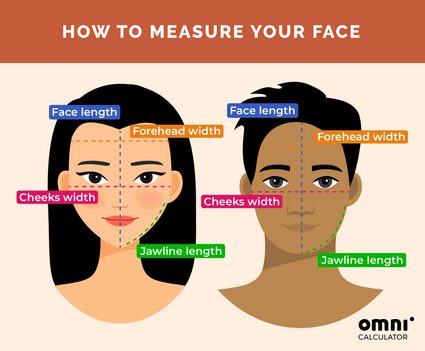
1. To get your forehead width, find the widest part of your forehead and measure it, starting from the hairline at each side. The widest point is usually located in the middle between your eyebrows and the top of your hairline.
2. For your face length, hold the measuring tape at the central point of your hairline and simply take it down all the way to the bottom of your chin.
3. For the width of your cheeks, measure the distance between the outer corner of your eyes,
4. Taking your jawline length is a bit more complicated than the previous parts. To get it, you need to place the measuring tape right under your ear, at the corner of your jaw. Then, bring it to the tip of your chin. You'll need to bend the tape a little to get an accurate result – that's why a flexible measuring tape is the best type to use! Theoretically, simply using the value you got on one side should be enough. In practice, people hardly ever have perfectly symmetrical faces, so there might be a minute difference in the lengths of the two sides of your jaw. We would recommend that you take a separate measurement for each side, and add the two values, then take the average.
Got your measurements? 📏 Now consider your face shape!
Now that you've got your measurements done, it's time for the next step. Let's use them to find your face shape! Follow our short guide to find out what are the defining features of each of the common face shapes, and compare yours to the illustrations if you're still unsure.
- OVAL
How to identify: You have an oval face if it's longer than it is wide, and your cheekbones are a bit wider than both your jaw and your forehead. Your forehead can be on the slightly taller side, and you might have prominent cheekbones.
Glasses to consider: square, rectangular, geometric, cat-eye, horn-rimmed.
Glasses to avoid: oval, round, oversized.
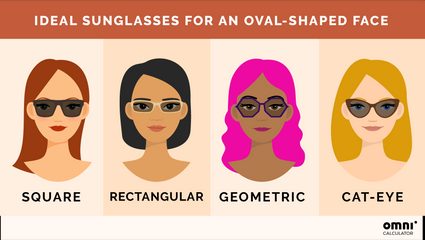
- OBLONG
How to identify: Also referred to as rectangular, this shape is very similar to the oval. The difference is that in an oblong face, the cheek line is longer and relatively straight.
Glasses to consider: round, square, aviator, brow-line, cat-eye.
Glasses to avoid: rectangular, thin, narrow.
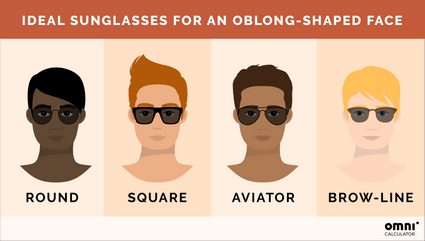
- ROUND
How to identify: Your face is a circle if your cheekbones at their widest are roughly the same width as the distance between your forehead and jaw. Your hairline and jawline are subtle, rounded lines.
Glasses to consider: rectangular, geometric, D-frames, wayfarer, cat-eye.
Glasses to avoid: round, oval, rimless.
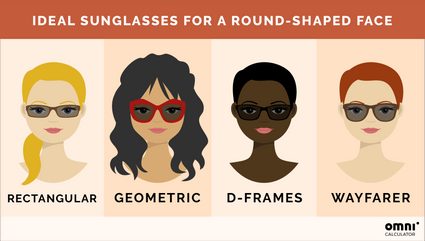
- SQUARE
How to identify: To say that your face is square, you need to be able to draw a relatively straight line along its sides (from forehead to jaw). You should have a strong, horizontal jawline, with the width and the length of your face roughly equal.
Glasses to consider: round, oval, brow-line, rimless, cat-eye.
Glasses to avoid square, rectangular.
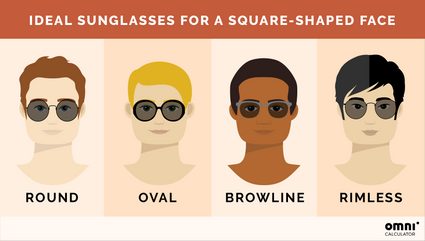
- TRIANGLE
How to identify: If your jaw is wider than your forehead, and your cheekbones are no wider than your chin, your face shape is a triangle. This shape is sometimes referred to as a pyramid in fashion.
Glasses to consider: D-frames, aviator, cat-eye, semi-rimless, horn-rimmed,.
Glasses to avoid: small, bottom-heavy models.
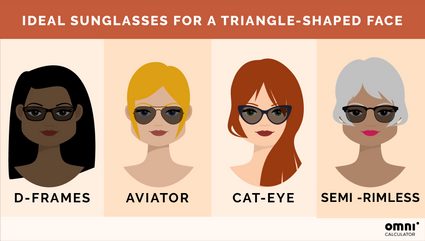
- DIAMOND
How to identify: If your cheekbones are prominent and wider than both your chin and your forehead, you likely have a diamond-shaped face. The lines along your face are also distincly more angular than in the oval shape.
Glasses to consider: cat-eye, oval, rimless, brow-line.
Glasses to avoid: rectangular, oversized.
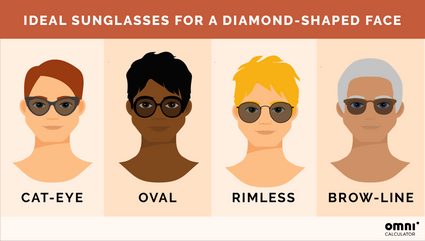
- HEART
How to identify: Also called an inverted triangle, this shape is characterized by a forehead and cheekbones that are the same width — or a forehead that is slightly wider than the cheekbones — with a significantly thinner chin.
Glasses to consider: oval, wayfarer, rimless, bottom-heavy.
Glasses to avoid: semi-rimless, cat-eye.
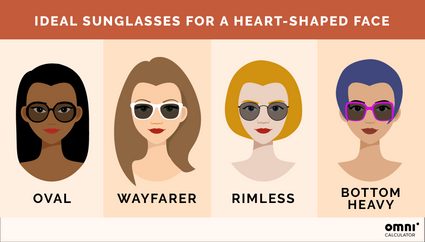
🔎 Want to learn about how to pick the best swimsuit? The Omni bikini body shape calculator is here to help!
Find your perfect pair! More tips on choosing the right sunglasses
We've covered the most important parts of choosing your perfect sunglasses. However, that's not all! There are many factors other than face shape and a size that fits that you should take into account while shopping for your perfect pair. Keep them in mind, and you're bound to find your match.
-
Make sure that your sunglasses block 100% of UV rays. You should be able to find a sticker or a tag that indicates whether your chosen pair provides sufficient protection. What you're looking for is a label with 100% UV-A and UV-B protection, or UV400 protection. If you can't find such information, you can always try asking your optometrist – in most cases, they should be able to perform a photometer test on-site. This is an extremely important thing to remember – dark shades without proper UV-block can actually make sunlight exposure more dangerous, as they cause your pupils to dilate, allowing more ultraviolet rays to penetrate the eyeballs.
-
Once you determine your ideal sunglasses model, consider getting the biggest pair that fits your requirements. The reason for this is simple – increasing the size of your shades will do the same to the area they cover, hence raising the level of protection. The bigger, the better! 😎
-
Black, brown, blue, or green – It does not make a difference from the UV protection's point of view! This means that you can choose the color of your sunglasses purely based on aesthetic preferences. The color does not influence the level of protection! This is true for the brightness as well – darker shades are not inherently better at filtering UV rays. In short – as long as you double-check that a pair you chose filters 100% of UV light, you can pick any color you want.
-
Polarization ≠ protection❗– Many people are under the false impression that polarized sunglasses offer better protection for your eyes, and might even ditch checking for UV-block in favor of the former. However, polarization alone does not affect how well the sunglasses protect the eyes from the detrimental effects of sunlight exposure. The aim of polarized glasses is to reduce glare ✨ and help you not squint in reflective surroundings such as water or snow. While shopping for sunglasses, keep in mind that glare reduction is secondary to UV protection!
Please note that in some cases, wearing polarized sunglasses might be dangerous! For example, if you wear them while skiing⛷️ or riding a motorcycle 🏍️, the glare reduction might make you miss a patch of ice or wet concrete.
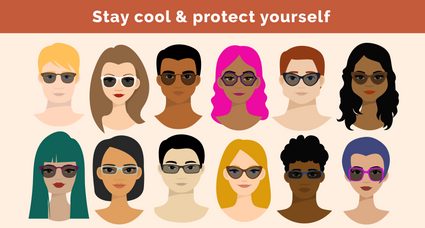
FAQs
How can I measure the size of a pair of sunglasses?
To measure the size of a pair of sunglasses, take three measurements in millimeters:
- The horizontal width of each lens at its widest point without the frame.
- Take the shortest span between the two lenses.
- Measure the length of the temples (or "arms") of the sunglasses.
- Combine these three numbers separated by spaces or dashes to find sunglasses that will fit perfectly.
How can I choose the correct size for a pair of sunglasses?
You can do this by measuring your face at several points (forehead, cheeks, jawline, and face length) and determining the shape of your face, which will help you decide what frames fit you best.
Other methods are to measure the size of your old sunglasses as a reference or use the credit card as a model of the standard lens size.
How can I measure my face for sunglasses?
Here's how to measure your face:
- Take a ruler and look in a mirror.
- Get the width of your forehead in the widest part.
- Find your cheeks' width from one outer corner of your eyes to the other.
- Measure your jawline length (from the corner of the jaw to the tip of the chin).
- Finally, take the length of your face from the hairline to the bottom of the chin.
What size is 52 mm in sunglasses?
If you see a size of 52 mm on a pair of sunglasses, it means that the width of the lens is 52 mm long. This number applies only to the clear lens through which you are looking. Usually, sunglasses have a lens width of 49 to 63 mm.
Is 59 mm big for sunglasses?
Yes, because the lens width of your sunglasses from their widest outer edges is as long as 59 mm. Companies use a standard size chart for sunglasses where:
- Small is 55 mm and below;
- Medium is between 55 mm and 58 mm; and
- Large falls between 58 mm and 63 mm.